Abstract
The study was conducted on the Obedska Bara Ramsar site at two localities, Krstonošića okno and canal Vok, to provide insight into fish community status by analysing fish biomass, biodiversity, and changes after restoration measures. A total of 685 fish samples were examined across four periods, from 2011 to 2023. Biodiversity index, relative biomass, and non-native species were analysed to evaluate the restoration measures’ influence. All parameters showed a negative trend until the restoration works were implemented, after which they increased. This study also provides recommendations to improve the site considering the Mission Restore our Ocean and Waters by 2030.
1. Introduction
Freshwaters and wetlands face significant threats driven by human activities, including nutrient loading, urban expansion, industrial pollution, deforestation, water extraction, flood control projects, sedimentation, and dam construction. Additional pressures arise from climate change, invasive species proliferation, disease outbreaks, algal blooms, hydropower development, emerging contaminants, microplastic accumulation, salinization, and declining calcium levels, among others [1,2]. Furthermore, these ecosystems are considered to be some of the most at risk, facing extinction threats that surpass those encountered in terrestrial and marine environments [3,4]. Despite occupying less than 1% of the Earth’s surface, these ecosystems are exceptionally diverse, serving as habitats for approximately 10% of all documented species and one-third of vertebrate species [5]. Their importance lies in the fact that they are not only biodiversity hotspots, but also areas of human activities, local and regional development, agriculture, tourism, industry, etc.
Ecosystem services provided by both wetlands and freshwaters are crucial for sustainability because they are the sources of biomass and food, and they also contribute to climate change mitigation by conducting carbon sequestration, regulating ecosystems after extreme weather events, stabilizing groundwater, purifying water, and improving air quality. These systems are also important due to their cultural services [6,7]. Freshwater ecosystems are vital for biodiversity, serving as key habitats for fish at various life stages. These fish significantly contribute to food webs by converting plant and animal matter, often originating externally, into resources for higher trophic levels [8]. The impact of wetland creation on fish communities remains underexplored, though the wetland’s geomorphological and geographical characteristics seem to play a crucial role in shaping fish community dynamics [9]. For this reason, restoring and preserving valuable wetlands and their geomorphological and geographical characteristics is essential. The structural complexity of wetlands is fundamental in maintaining high species diversity and ecosystem functions. Species such as fish, which are integral to wetland food webs, rely on habitat features like submerged vegetation and water level variability for shelter and foraging. Studies suggest that increasing habitat complexity through the reintroduction of native plant species and the removal of sediment deposits can enhance the resilience of fish populations and their capacity to support higher trophic levels [10]. Additionally, adaptive management that adjusts conservation measures in response to hydrological and seasonal variations can optimize biodiversity outcomes by aligning restoration with natural wetland dynamics.
Especially important wetland areas are Ramsar sites, protected by the Ramsar Convention which currently counts 172 countries as Contracting Parties that recognise the importance of a single ecosystem-focused international treaty [11]. The importance of Ramsar sites has been emphasized by the European Commission through initiatives such as the “Restore our Ocean and Waters” mission, which aims to combat the deterioration of wetlands and freshwater ecosystems [12]. The mission underscores that approximately 70% of wetlands have been degraded or eliminated as a result of pressures such as land conversion, river alterations, and the building of dams [12,13].
Based on the aforementioned, the restoration actions need to be a priority in response to the increasing deterioration of wetlands/freshwaters and biodiversity loss, especially in ecosystems of key importance to Europe, such as the Obedska Bara Ramsar site (Figure 1).
The Obedska Bara (Ramsar site No. 136) is one of the world’s oldest protected areas, having been under protection since 1874, when the Reserve was first established by Count Mollinary, up to contemporary protection [14]. This region forms a part of the Sava River floodplain and is subject to seasonal inundation which creates a diverse array of habitats such as marshes, ponds, wet meadows, and an oxbow lake. The vegetation consists of reedbeds and woodlands dominated by species from the willow-poplar and oak families [15,16,17]. With its rich biodiversity spanning fish, bird species, diverse vegetation, and unique landscapes, Obedska Bara was recognized by the HORIZON Europe Lighthouse project DaWetRest [18] as one of the key sites within the Danube River Basin (Figure 1). The basin serves as a cradle of freshwater biodiversity whose sustainability is important for many sectors of Europe, especially agriculture, forestry, economy, tourism, and nature protection [19,20]. The area of Obedska Bara is part of the wider Emerald ecological network, with significantly preserved wildlife species and their habitat [21]. Moreover, it is defined as the region of Serbia that will be nominated for inclusion on the list of biosphere reserve under the UNESCO Man and Biosphere Program (MAB Program).
Due to the aforementioned, science and water management are essential for providing clear insight into the status and perspective of valuable Danube River Basin ecosystems such as Obedska Bara and the mentioned DaWetRest project plays an important role since it develops a strategy for wetland improvement considering valuable wetlands from Hungary, Croatia, Serbia, and Bosnia and Herzegovina.
This work aims to evaluate the status of the Obedska Bara Ramsar site using biodiversity metrics, including biomass, annual fish production, and biodiversity indices, which can serve as a critical resource for developing strategies and methodologies to enhance restoration efforts. This study provides important data on which the recommendations for ecosystem improvement will be based.
The main goal of the study is to provide insight into fish community composition before and after the conducted restoration action on the Obedska Bara Ramsar site. The main hypothesis is that the conducted restoration action as part of the wetland management positively contributes to the increase in fish biomass and biodiversity.
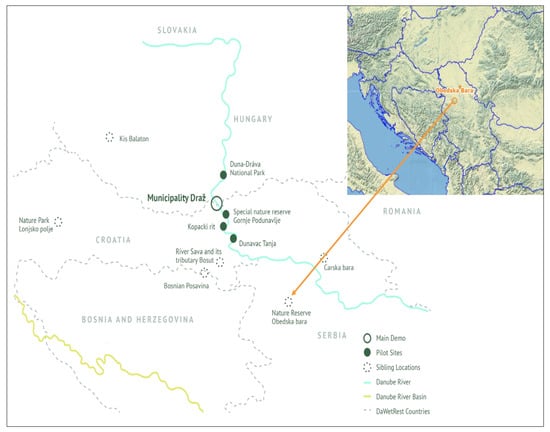

Figure 1.
Location of the “Obedska Bara” Special Nature Reserve within the DaWetRest project: Main Demo-location were active restoration measures will be conducted within the DaWetRest activities, Pilot Sites-location of interested on the Danube River Bank, Sibling Locations-location of interested belonging to the Danube River Basin [17,18].
2. Materials and Methods
2.1. Study Area
Located in the southern part of the Pećinci municipality which includes villages of Ašanja, Ogar, Kupinovo, and Obrež, and extending into Ruma municipality with the village of Grabovci, the Special Nature Reserve “Obedska Bara” spans 196 km2, representing 2.4% of the Srem region. The area features diverse landscapes such as marshlands, floodplain meadows, forests, agricultural land, and settlements. Its geographical boundaries are defined by the coordinates 43°38′–44°48′ N and 19°47′–20°09′ E. The alluvial plain forming the Obedska Bara Special Nature Reserve extends northward to the villages of Grabovci, Obrež, and Kupinovo and southward to the Sava River, encompassing roughly 100 km2. Positioned at an elevation of about 74 m, this area comprises sediment layers of silt and sand deposited by the Sava River. Between Obrež to the west and Kupinovo to the east lies a horseshoe-shaped remnant of the Sava’s former riverbed, now referred to as “Obedska Bara”. This feature is currently a series of interconnected lakes and ponds (Figure 2), linked to the Sava River by the Vok Canal to the east and the Revenica Canal to the west [22,23,24]. This unique hydrological connectivity plays a vital role in nutrient cycling, species migration, and overall biodiversity, as seasonal flooding introduces nutrients and supports dynamic ecological processes within the reserve.
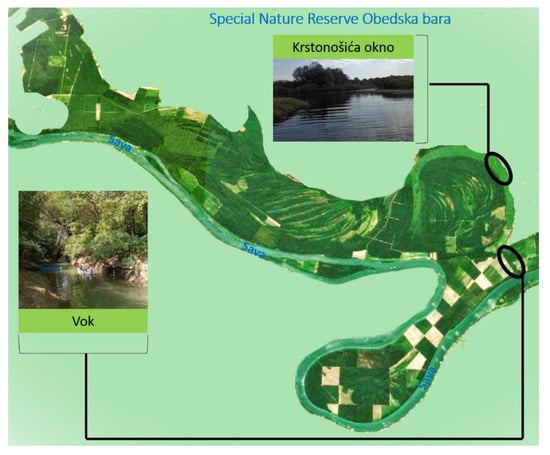
Figure 2.
Position of sampling localities at the Obedska Bara Special Nature Reserve (Source: Copernicus Browser, modified by authors).
2.2. Sampling Localities
Locality Krstonošića okno (44°44′23.9″ N; 20°01′25.3″ E, altitude 81 m) is the widest pond and is located near the village of Obrež (Figure 2). It is about 600 m long, 50–60 m wide, and up to 5 m deep. The size of the shaft fluctuates with the Sava River’s water levels, which directly influence the volume of water within Obedska Bara. Marsh communities overgrow most of the riverbed, Obedska Bara and other larger ponds, as well as in depressions that are flooded throughout the year. In the Phragmito-Salicetum cinereae community, described in Krstonošića okno, marsh fern is a sub-edificator and differential species growing in shallow waters and open areas [25,26]. Published data indicate that this species inhabits wetlands in riparian forests and marshes (the communities Alnetum glutinosae and Scirpo-Phragmitetum) in Serbia [27,28]. The Phragmito-Salicetum cinerae community is important for the life and nesting of waterbirds and the formation of colonies. Common reed and wood clubrush (Scirpo-Phragmitetum) also spread around water fountains, as well as sweet flag (Acoretum calami). Fine-leaved water-dropwort and watercress (Oenathae-Roripetum) recorded phragmatically. Macrophytic vegetation analysis classifies the trophic status as eutrophic, reflecting nutrient-rich conditions that foster both high productivity and biodiversity.
Locality Vok (44°41′12.3″ N; 20°02′40.0″ E, altitude 72 m): Between the Sava River and Kupinovo towards the village of Skela is the Vok canal, about 10 m wide and about 2 m deep (Figure 2). This canal was dug on the site of the old, natural branch of the Sava, creating a connection with the Gradska pond. During high water levels, the canal allows the Sava’s water to flow into Obedska Bara, replenishing nutrient levels and maintaining ecological balance. When the Sava’s water level is low, water returns from the pond to the river. Macrophytic vegetation indicates mesotrophic to eutrophic conditions [29].
2.3. Sampling Methodology, Data Collection and Processing
Between July 2011 and October 2023, 685 fish specimens were collected through single-pass point-sample electrofishing (HONDA, Tokyo, Japan, 1.2 kW, LONCIN 2.2 kW, LC 2000, input 12 V per maximum 8.3A DC, output 500 V, and frequency 65 P s−1) at the two previously described sampling sites (Figure 2). Taxonomic identification of the specimens was conducted using FishBase [30], followed by measurements and assessments of relative biomass (kg/ha) and annual production (kg/ha). The calculation of relative biomass utilized data from all collected fish samples during the study period, applying methods established by Ricker in 1958 [31]. This method is widely used and reliable in fisheries biology. By this method, production is estimated as simply the product of the estimated instantaneous growth rate and estimated mean biomass as P^ G^ = G^B–, where P^ = estimated production for a given cohort within a specified interval, = estimated instantaneous growth rate for the cohort from time t to t + 1, and B– = estimated arithmetic mean cohort biomass from time t to t + 1 (i.e., B^ t + B^ t+1)/2). Data processing utilised STATISTICA 12 software for comparing results across the investigation period and between sampling areas. Statistical analyses included one-way ANOVA, Friedman ANOVA, MANOVA and Kendall’s Coefficient of Concordance to assess variations and identify correlations. In addition to biomass and production analyses, biodiversity was assessed using the Shannon Index, which measures species richness and evenness. This index provided insight into biodiversity fluctuations over the study period and highlighted differences in biodiversity status between the two sites. The Shannon Index was applied as a reliable metric to assess ecosystem health and resilience under environmental pressures [32].
3. Results
3.1. Fish Biodiversity and Ecosystem Changes
During the investigation period, 23 fish species were taxonomically identified at both localities (Table 1, Figure 3). Figure 3 displays species abundance throughout the investigation period, illustrating frequency patterns and trends. This graphical overview provides insights into species distributions across the two localities. Table 1 presents identified species and their status. The status of the species is framed according to applicable national and international legislation and directives. Status 1 reflects species of European conservation concerning [33], Status 2 corresponds to species under EU-level protection concerning [34], and Status 3 pertains to those covered by national regulations [35]. Additionally, the “+” sign indicates allochthonous (non-native) species.

Table 1.
Taxa composition and status according to international and national regulations (- alien fish species).
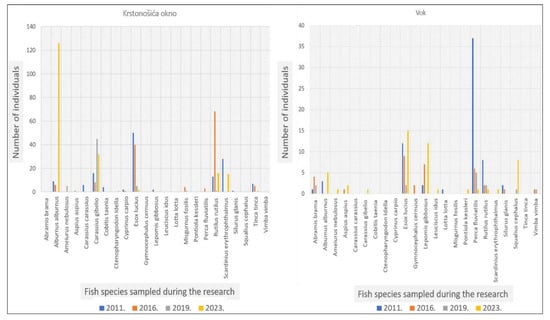
Figure 3.
Graphical overview on frequency of fish species in the total fish sample per sampling years in Krstonošića okno (left) and Vok (right).
Figure 4 illustrates the contributions of indigenous and alien fish species to biomass totals in 2011, 2016, 2019, and 2023, highlighting the sustained dominance of indigenous species. Over the study period, the relative biomass of alien species showed no significant changes, with fluctuations within a seven percent range.
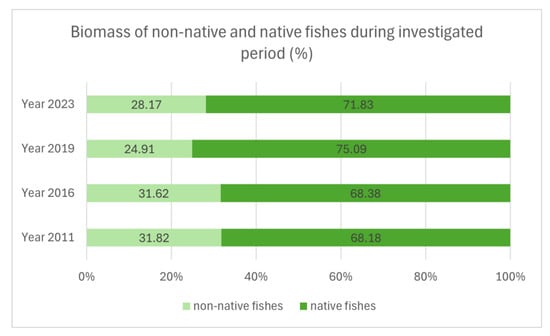
Figure 4.
Biomass dynamics of native and non-native fish across the study period.
3.2. Biodiversity and Biomass Trends
- Shannon Biodiversity Index
The Shannon biodiversity index was calculated for each year of monitoring (Figure 5). The results of the one-way ANOVA indicated no statistically significant variation in the Shannon index across the investigated years (F(3,4) = 0.36480; p > 0.05). However, a noticeable decrease in the Shannon index was observed in 2019, coinciding with restoration activities at the Obedska Bara Ramsar site, which involved barrier removal and channel cleaning. Following these interventions, the final monitoring activities indicated an increase in the Shannon index, suggesting a positive biodiversity response to habitat restoration. Differences in the Shannon index between localities were not statistically significant, although canal Vok demonstrated consistently higher values throughout the period (F(1,6) = 2.0511; p > 0.05), indicating its relative diversity and habitat complexity.

Figure 5.
Shannon index of biodiversity: comparison between the years of investigation (left) and comparison between localities (right).
- Relative biomass and relative annual production
To evaluate ecosystem changes linked to past wetland degradation, the relative biomass and annual production of the collected fish were examined. Friedman ANOVA was used to show statistical significance across the study period. No significant changes were observed in relative and absolute biomass (Figure 6). However, data indicated a decrease in relative biomass and annual production in 2019, likely reflecting temporary disruptions from restoration activities. After the restoration conducted in 2021, both parameters showed a clear increase, indicating a positive response of the fish community to the restoration activities (Figure 6 and Figure 7).
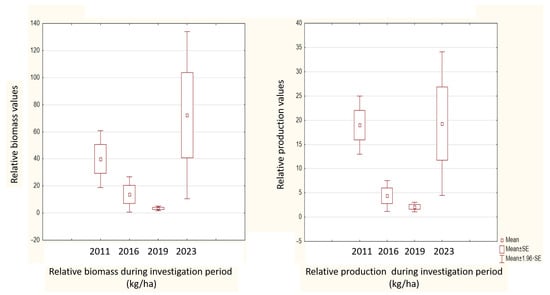
Figure 6.
Left: Relative biomass through the investigation period Friedman ANOVA (N = 9, df = 3) = 1.933333 p > 0.05; Right: relative annual production through the investigation period (Friedman ANOVA (N = 2, df = 3) = 6.000000 p > 0.05).
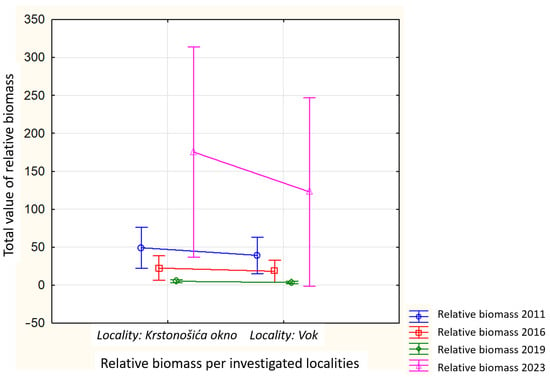
Figure 7.
Differences in relative biomass over the years of investigation.
MANOVA tests were conducted to identify potential differences in relative biomass over the years of investigation. Figure 7 shows that both localities exhibited higher values for relative biomass in some years compared to others, though these differences were not statistically significant (Wilkins lambda 0.63563; F(4,4); p > 0.05). Furthermore, Krstonošića okno consistently displayed higher relative biomass values across the years studied, whereas canal Vok maintained a higher Shannon index, suggesting greater species diversity and richness despite lower biomass density (Figure 5). This pattern may reflect habitat variation between the two sites, with Krstonošića okno providing conditions favorable to biomass accumulation, while canal Vok’s diversity might be attributed to its role as a migratory corridor and nutrient pathway.
4. Discussion
River-associated wetlands, such as those at the Obedska Bara Ramsar site, harbour a rich diversity of fish species (Table 1) adapted to fluctuating water conditions. Fish in these environments can either endure habitat desiccation during low-water periods or migrate with flood cycles, which bring periodic pulses of nutrients essential for maintaining high productivity [9].
The results of our research on biomass and annual production show the fluctuation during the investigation period, aligning with findings from previous studies [37,38]. Nations adhering to the Ramsar Convention have pledged to protect and manage these ecosystems sustainably, aiming to safeguard their critical ecological roles and support both environmental health and human well-over the long term. To promote environmental protection and enhancement, it is essential to halt ongoing degradation and implement measures for prevention, restoration, and revitalization of threatened areas. Establishing and maintaining a national register of pollution sources, along with a control and monitoring system, is important for an effective long-term management of these ecosystems. Moreover, it is necessary to plan for the protection, restoration, and rehabilitation of designated natural areas while ensuring ecological balance and resilience. The graphs in Figure 6 and Figure 7 demonstrate a modest upward trend in both biomass and annual production following the implementation of revitalization measures, suggesting a potential positive impact of the interventions undertaken in 2021 [39]. In general, the fish species present in the area are representative of the entire Pannonian Basin [40]. Thirteen species are strictly protected, rare, or endangered, and are distributed throughout the Obedska Bara. Native species are dominant; however, invasive species, such as tentative Carassius gibelio and Lepomis gibbosus, have also become established, raising concerns about interspecies competition and potential hybridization, that may threaten native biodiversity. The fish fauna in the reserve is notably diverse, with a mix of autochthonous (native) and some allochthonous (introduced) species. However, this diversity is diminished, and certain populations are endangered due to habitat pressures and invasive species. Among the 23 identified fish species, several are of conservation concern, highlighting the need for targeted management to prevent further declines and ensure genetic diversity.
The long-term monitoring of fish communities in Obedska Bara revealed that non-native fish species consistently contributed between 25% and 32% to the total biomass over a ten-year period (Figure 4). This stability indicates that the ecosystem has reached a new equilibrium, and that biodiversity can be maintained in human-modified aquatic environments through effective management strategies.
Total fish biomass and the biomass of species of high fisheries importance and functional diversity tended to decrease with flooding, suggesting that potential niche complementarity may have an influence on species coexistence in wetlands. If functional traits do indeed influence fish biomass dynamics in response to habitat changes, functional traits could be an effective means of predicting future changes in fish assemblage composition as floodplains change in response to natural and anthropogenic processes [41]. Although the consequences of the presence of invasive species are well known, there have been no significant shifts in the distribution of non native fish species compared to native species over the last ten years indicating a stable state under current environmental conditions.
Ecosystem stability is heavily dependent on biodiversity, and changes in biodiversity can significantly impact ecosystem function. Therefore, investigating this connection is essential for our understanding and conservation of ecosystems.
In recent decades, numerous negative factors, such as disruptions of the water regime, eutrophication, ecological succession, sedimentation, and heavy metal accumulation, have visibly disturbed the area’s ecological dynamics [42]. Human activities, including the construction of canals, elevation of embankments, and inadequate conservation efforts, have diminished the area’s ecological value. The shrinkage of open water bodies and wet meadows, coupled with the degradation of the region’s wetland characteristics, has significantly harmed biodiversity and disrupted essential ecosystem services, adversely affecting both plant and animal life. The changes in water and sediment quality, terrain morphology, and aquatic community structure have led to a decline in overall biodiversity, particularly within aquatic ecosystems. However, hydrotechnical interventions at Obedska Bara in 2021 have allowed for improved water regime management, contributing positively to ecological balance and the overall health of the wetland.
Given the role of Ramsar sites in biodiversity preservation, the valuation of ecosystem services could be integrated into the Obedska Bara’s management plan to quantify and communicate the ecological and economic benefits of conservation efforts. Our research shows that biodiversity indices change in a similar way to other fishery parameters, i.e., they show a long-term downward trend, but slowly improve after certain habitat restoration measures are taken (Figure 7). Certain indices may reveal positive, negative, or stable patterns in biodiversity [43].
Tools such as cost-benefit analysis and ecosystem service accounting could support decision-making by illustrating the long-term value of restored biodiversity against potential losses from habitat degradation. Protecting this rich ichthyofauna is essential for sustaining the region’s gene pool, which supports bird populations reliant on fish for nutrition and ecosystem stability [44,45]. To protect the fish gene pool and support ecological balance, future actions should focus on maintaining a steady, ecologically appropriate water flow and regulating the timing and duration of seasonal floods. This can be achieved through controlled water flow management between Vranj, Revenica, and Potkovica. This can be achieved by connecting water mains and building or maintaining the existing dedicated channels at the entrance and exit channels (Vok, Revenica, and Vranj) in alignment with the requirements of nature protection and forestry.
Additionally, regular cleaning of ponds (water mirrors) within the protected area is critical, particularly in areas with high siltation rates, such as the bed of Obedska Bara. Removing accumulated debris and cleaning channels from branches, sediment deposits, and other obstructive materials, especially in key channels like Vok and Revenica, is essential to prevent flow hindrance and ensure habitat quality.
Continued restoration projects, such as those targeting Potkovica in the Krstonošića okno area, will further enhance habitat conditions. Such projects not only improve water quality and flow dynamics, but also support the establishment of native vegetation that stabilises sediment and provides habitat structure for aquatic organisms. Lastly, preventing illegal fishing, controlling invasive species, and implementing strict anti-poaching measures are essential to safeguarding the Reserve’s fish populations. This includes establishing monitoring protocols and strengthening enforcement to deter activities that endanger fish species. These combined efforts are essential to ensure the long-term resilience and ecological integrity of Obedska Bara’s fish communities and their vital role within the ecologically significant Ramsar site.
Author Contributions
Conceptualization, V.N. and Z.N.; Methodology, V.N., Z.N., D.Š.J. and R.N.; Investigation, V.N. and Z.N.; Formal analysis, V.N., Z.N. and P.S.; Visualization, R.N. and P.S.; Writing—original draft preparation, V.N., Z.N. and R.N.; Writing—review and editing, V.N., V.Đ. and P.S. All authors have read and agreed to the published version of the manuscript.
Funding
This work was funded by the Ministry of Science, Technological Development, and Innovation of the Republic of Serbia (Contracts 451-03-66/2024-03/200007 and No. 451-03-66/2024-03/200178). This work is a part of the Danube Wetlands and floodplains Restoration through systemic, community engaged and sustainable innovative actions (DaWetRest) project, which is co-funded by the European Union Horizon Europe program (HORIZON-MISS-2022-OCEAN-O1-02), under Grant Agreement no. 101113015. Views and opinions expressed are however those of the author(s) only and do not necessarily reflect those of the European Union or CINEA. Neither the European Union nor the granting authority can be held responsible for them.
Institutional Review Board Statement
There was no need for the approval from an Ethical Committee for this study, because this species is used in commercial fishing. Moreover, authors had approval of the Ministry of Environmental Protection and Environmental Protection Agency for conducting the study.
Data Availability Statement
All data generated or analyzed during this study are included in these published articles.
Acknowledgments
This research was conducted in collaboration with Vojvodinašume, a public institution responsible for managing forests in Vojvodina, as part of their ongoing monitoring of fish populations. We would like to express our gratitude to our colleagues from Obedska Bara Nature Park for their valuable assistance.
Conflicts of Interest
The authors declare no conflicts of interest.
References
- Cosgrove, W.J.; Rijsberman, F.R. World Water Vision: Making Water Everybody’s Business, 1st ed.; Routledge: Abingdon, UK, 2000; p. 136. ISBN 9781315071763. [Google Scholar]
- Reid, A.J.; Carlson, A.K.; Creed, I.F.; Eliason, E.J.; Gell, P.A.; Johnson, P.T.J.; Kidd, K.A.; MacCormack, T.J.; Olden, J.D.; Ormerod, S.J.; et al. Emerging threats and persistent conservation challenges for freshwater biodiversity. Biol. Rev. 2019, 94, 849–873. [Google Scholar] [CrossRef] [PubMed]
- Winemiller, K.O. Trends in Biodiversity: Freshwater. Encycl. Anthr. 2018, 3, 151–161. [Google Scholar] [CrossRef]
- Ağdamar, E.; Saç, G.; Gaygusuz, Ö.; Doğaç, E.; Acar, Ü.; Gaygusuz Çiğdem, G.; Özuluğ, M. The ichthyofaunal diversity of freshwater ecosystems in Gökçeada Island (NW Turkey) under the pressure of nonnative species. Turk. J. Zool. 2021, 45, 6. [Google Scholar] [CrossRef]
- Strayer, D.L.; Dudgeon, D. Freshwater biodiversity conservation: Recent progress and future challenges. J. N. Am. Benthol. Soc. 2010, 29, 344–358. [Google Scholar] [CrossRef]
- Bhowmik, S. Ecological and Economic Importance of Wetlands and Their Vulnerability: A Review. In Research Anthology on Ecosystem Conservation and Preserving Biodiversity; Information Resources Management Association, IGI Global: Hershey, PA, USA, 2022; pp. 11–27. [Google Scholar] [CrossRef]
- Lipton, D.; Rubenstein, M.A.; Weiskopf, S.R.; Carter, S.; Peterson, J.; Crozier, L.; Fogarty, M.; Gaichas, S.; Hyde, K.J.W.; Morelli, T.L.; et al. Ecosystems, Ecosystem Services, and Biodiversity. In Impacts, Risks, and Adaptation in the United States: Fourth National Climate Assessment; U.S. Global Change Research Program: Washington, WA, USA, 2018; Volume II, pp. 268–321. [Google Scholar] [CrossRef]
- Bruton, M.N.; Jackson, P.B.N. Fish and fisheries of wetlands. J. Limnol. Soc. S. Afr. 1983, 9, 123–133. [Google Scholar] [CrossRef]
- Rewa, C. Biological responses to wetland restoration: Implications for wildlife habitat development through the Wetlands Reserve Program. In A Comprehensive Review of Farm Bill Contributions to Wildlife Conservation 1985–2000; Hohman, W.L., Halloum, D.J., Eds.; Technical Report; USDA (U.S. Department of Agriculture): Washington, WA, USA; NRCS (Natural Resources Conservation Service): Washington, WA, USA; WHMI (Wildlife Habitat Management Institute): Washington, WA, USA, 2000; pp. 95–116. [Google Scholar]
- Mayfield, A.E.; Seybold, S.J.; Haag, W.R.; Johnson, M.T.; Kerns, B.K.; Kilgo, J.C.; Larkin, D.J.; Lucardi, R.D.; Moltzan, B.D.; Pearson, D.E.; et al. Impacts of Invasive Species in Terrestrial and Aquatic Systems in the United States. In Invasive Species in Forests and Rangelands of the United States; Poland, T.M., Patel-Weynand, T., Finch, D.M., Miniat, C.F., Hayes, D.C., Lopez, V.M., Eds.; Springer: Cham, Germany, 2021; pp. 5–41. [Google Scholar] [CrossRef]
- Ramsar Convention on Wetlands. Global Wetland Outlook: State of the World’s Wetlands and their Services to People; Ramsar Convention Secretariat: Gland, Switzerland, 2018; pp. 1–88. Available online: https://www.ramsar.org/sites/default/files/documents/library/strp19_4_bn7_e.pdf (accessed on 4 December 2024).
- Available online: https://research-and-innovation.ec.europa.eu/system/files/2021-09/ocean_and_waters_implementation_plan_for_publication.pdf (accessed on 7 October 2024).
- Hein, T.; Schwarz, U.; Habersack, H.; Nichersu, I.; Preiner, S.; Willby, N.; Weigelhofer, G. Current status and restoration options for floodplains along the Danube River. Sci. Total Environ. 2016, 543, 778–790. [Google Scholar] [CrossRef] [PubMed]
- Markićević, M. Zaštita i unapređenje SRP Obedska bara (Protection and promotion Spatial Reserve of Nature Obedska bara). Bull. Fac. Geogr. 2002, 145–158. [Google Scholar]
- Puzović, S. Ramsar areas in Serbia [Yugoslavia] and their function in preservation of diversity of birds in watery habitats. Prot. Nat. 1998, 283–290. [Google Scholar]
- Tubić, B.; Rađević, V.; Marinković, M.; Vasić, I.; Petrović, N. Forest management in the first level of protection at the Special Nature Reserve “Obedska Bara”. Glas. Sumar. Fak. 2023, 135–144. [Google Scholar] [CrossRef]
- Ramsar. Information Sheet on Ramsar Wetlands—Obedska Bara. Available online: https://rsis.ramsar.org/ris/136 (accessed on 7 October 2024).
- Available online: www.dawetrest.eu (accessed on 7 October 2024).
- Sommerwerk, N.; Bloesch, J.; Paunović, M.; Baumgartner, C.; Venohr, M.; Schneider-Jacoby, M.; Hein, T.; Tockner, K. Managing the world’s most international river: The Danube River Basin. Mar. Freshw. Res. 2010, 61, 736–748. [Google Scholar] [CrossRef]
- Available online: https://www.icpdr.org/danube-basin/danube-river-basin (accessed on 7 October 2024).
- Ćurčić, N.; Đurđić, S. The actual relevance of ecological corridors in nature conservation. Zb. Rad. Geogr. Instituta “Jovan Cvijić” SANU 2013, 63, 21–34. [Google Scholar] [CrossRef]
- Krajić, A. Geoekološko vrednovanje područja Rezervata prirode “Obedska bara” (Geoecological Evaluation of the Area of Nature Reserve “Obedska bara”). Bull. Serbian Geogr. Soc. 2011, 4, 15–26. [Google Scholar]
- Letić, L.; Đeković, V.; Mihajlović, B. Obedska bara i njen uticaj na režim voda u “Kupinskim Gredama“(Obedska bara and its effect on water regime in “Kupinske Grede”). Bull. Fac. For. 2008, 97, 187–196. [Google Scholar]
- Pavić, D.; Jakovljević, D.; Krajić, A. Local Reactions Concerning Serbia’s Obedska bara Nature Reserve. Pol. J. Environ. Stud. 2016, 25, 273–282. [Google Scholar] [CrossRef]
- Janković, M. Thelyptero-Phragmito-Salicetum cinereae m. jank. 1994. In Vegetacija Srbije II–Šumske Zajednice; Sarić, M., Ed.; Srpska akademija nauka i umetnosti: Beograd, Serbia, 1997; pp. 121–125. [Google Scholar]
- Nikolić, V.; Jokanović, D. Watering regime influence on sustainability of floristic structure of special nature reserve “Obedska bara”. In Forests of Southeast Europe Under a Changing Climate; Šijačić-Nikolić, M., Milovanović, J., Nonić, M., Eds.; Springer: Berlin/Heidelberg, Germany, 2018; pp. 459–477. [Google Scholar]
- Vukićević, E. Odeljak: Pteridophyta-Papratnjače. In Flora Srbije 1; Sarić, M., Ed.; Srpska akademija nauka i umetnosti: Beograd, Serbia, 1992; pp. 71–160. [Google Scholar]
- Jokanović, D.; Desimirović, I. Analysis of medicinal plants at the area of Special Nature Reserve. Ecologica 2022, 29, 337–342. [Google Scholar] [CrossRef]
- Panjković, B.; Kiš, A.; Kovačević, B.; Pil, N.; Mikeš, V.H.; Dobretić, V.; Stojšić, V.; Sabadoš, K.; Stojnić, N.; Delić, J.; et al. Monitoring živog sveta vlažnih staništa u SRP “Obedska bara”. In Monitoring Osetljivih Ekosistema Ugroženih Biljnih i životinjskih Vrsta na Teritoriji AP Vojvodine; Zavod za zaštitu prirode Srbije: Novi Sad, Serbia, 2008; pp. 22–33. [Google Scholar]
- Froese, R.; Pauly, D. FishBase. Available online: www.fishbase.org (accessed on 7 October 2024).
- Ricker, W.E. Production, reproduction and yield. Veroff. Limnol. 1958, 13, 84–100. [Google Scholar]
- Magurran, A.E.; McGill, B.J. Biological Diversity: Frontiers in Measurement and Assessment; Oxford University Press: Oxford, UK, 2011; pp. 1–368. [Google Scholar]
- Council of Europe. Convention on the Conservation of European Wildlife and Natural Habitats (ETS No. 104). 1979, Bern, 19.IX.1979. Available online: https://www.coe.int/en/web/bern-convention (accessed on 4 December 2024).
- Council of the European Union. Council Directive 92/43/EEC of 21 May 1992 on the Conservation of Natural Habitats and of Wild Fauna and Flora. 1992. Available online: https://eur-lex.europa.eu/LexUriServ/LexUriServ.do?uri=CONSLEG:1992L0043:20070101:en:PDF (accessed on 4 December 2024).
- Convention on the Conservation of Migratory Species of Wild Animals. Rulebook on Proclamation and Protection of Strictly Protected and Protected Wild Species of Plants, Animals and Fungi. 2010 (“Official Gazette of RS”, No. 5/10, 47/11, 32/16 and 98/16, 01 January 2010). Available online: https://www.cms.int/en/document/rulebook-proclamation-and-protection-strictly-protected-and-protected-wild-species-plants (accessed on 4 December 2024).
- IUCN. The IUCN Red List of Threatened Species. Version 2023-1. 2023. Available online: https://www.iucnredlist.org/ (accessed on 4 December 2024).
- Quiros, R. Predictors of Relative Fish Biomass in Lakes and Reservoirs of Argentina. Can. J. Fish. Aquat. Sci. 1990, 47, 928–939. [Google Scholar] [CrossRef]
- Nikolić, V.; Nedić, Z.; Škraba Jurlina, D.; Djikanović, V.; Kanjuh, T.; Marić, A.; Simonović, P. Status and Perspectives of the Ichthyofauna of the Labudovo okno Ramsar Site: An Analysis of 14 Years of Data. Sustainability 2023, 15, 9303. [Google Scholar] [CrossRef]
- JP Vojvodinasume: Plan Upravljanja SRP Obedska Bara 2021–2030. Available online: https://www.vojvodinasume.rs/wp-content/uploads/2022/03/Plan-upravljanja-OB_2021-2030_medium-compressed.pdf (accessed on 4 December 2024).
- Simić, V.; Lujić, J.; Kostić, D.; Ćirković, M.; Bjelić Čabrilo, O.; Simić, S.; Marković, G. Diversity characteristics of the fish species important for fishery in the waters of Serbia. Bulg. J. Agric. Sci. 2013, 19, 77–87. [Google Scholar]
- Arantes, C.C.; Winemiller, K.O.; Asher, A.; Castello, L.; Hess, L.L.; Petrere, M.; Freitas, C.E.C. Floodplain land cover affects biomass distribution of fish functional diversity in the Amazon River. Sci. Rep. 2019, 9, 16684. [Google Scholar] [CrossRef] [PubMed]
- Darwall, W.R.T.; Freyhof, J. Lost fishes, who is counting? The extent of the threat to freshwater fish biodiversity. In Conservation of Freshwater Fishes; Closs, G.P., Krkosek, M., Olden, J.D.E., Eds.; Conservation Biology; Cambridge University Press: Cambridge, UK, 2015; pp. 1–36. [Google Scholar] [CrossRef]
- Lazar, L.; Rodino, S.; Pop, R.; Tiller, R.; D’Haese, N.; Viaene, P.; De Kok, J.-L. Sustainable Development Scenarios in the Danube Delta—A Pilot Methodology for Decision Makers. Water 2022, 14, 3484. [Google Scholar] [CrossRef]
- Kitikidou, K.; Milios, E.; Stampoulidis, A.; Pipinis, E.; Radoglou, K. Using Biodiversity Indices Effectively: Considerations for Forest Management. Ecologies 2024, 5, 42–51. [Google Scholar] [CrossRef]
- Tomscha, S.; Jackson, B.; Benavidez, R.; de Róiste, M.; Hartley, S.; Deslippe, J. A multiscale perspective on how much wetland restoration is needed to achieve targets for ecosystem services. Ecosyst. Serv. 2023, 61, 101527. [Google Scholar] [CrossRef]
Disclaimer/Publisher’s Note: The statements, opinions and data contained in all publications are solely those of the individual author(s) and contributor(s) and not of MDPI and/or the editor(s). MDPI and/or the editor(s) disclaim responsibility for any injury to people or property resulting from any ideas, methods, instructions or products referred to in the content. |
© 2025 by the authors. Licensee MDPI, Basel, Switzerland. This article is an open access article distributed under the terms and conditions of the Creative Commons Attribution (CC BY) license (https://creativecommons.org/licenses/by/4.0/).